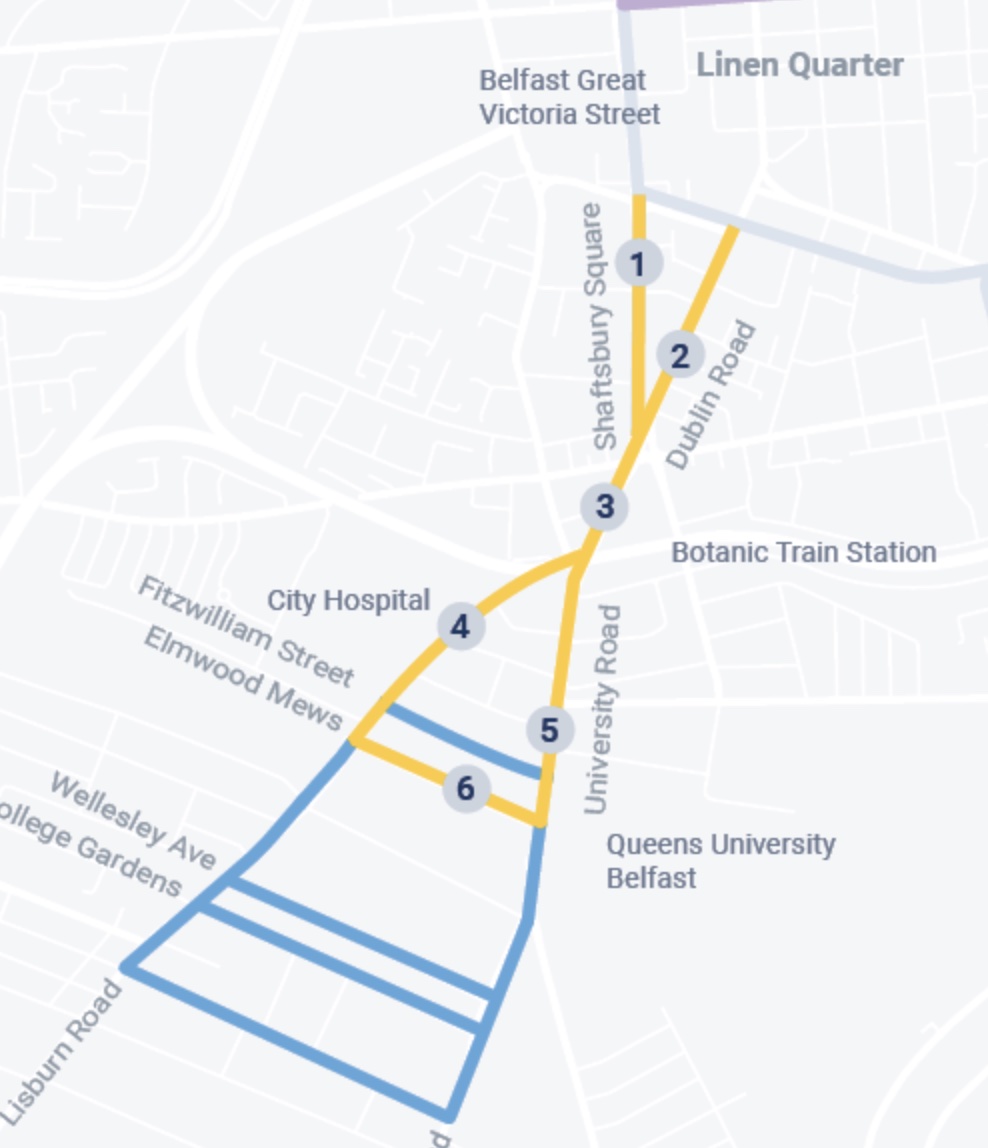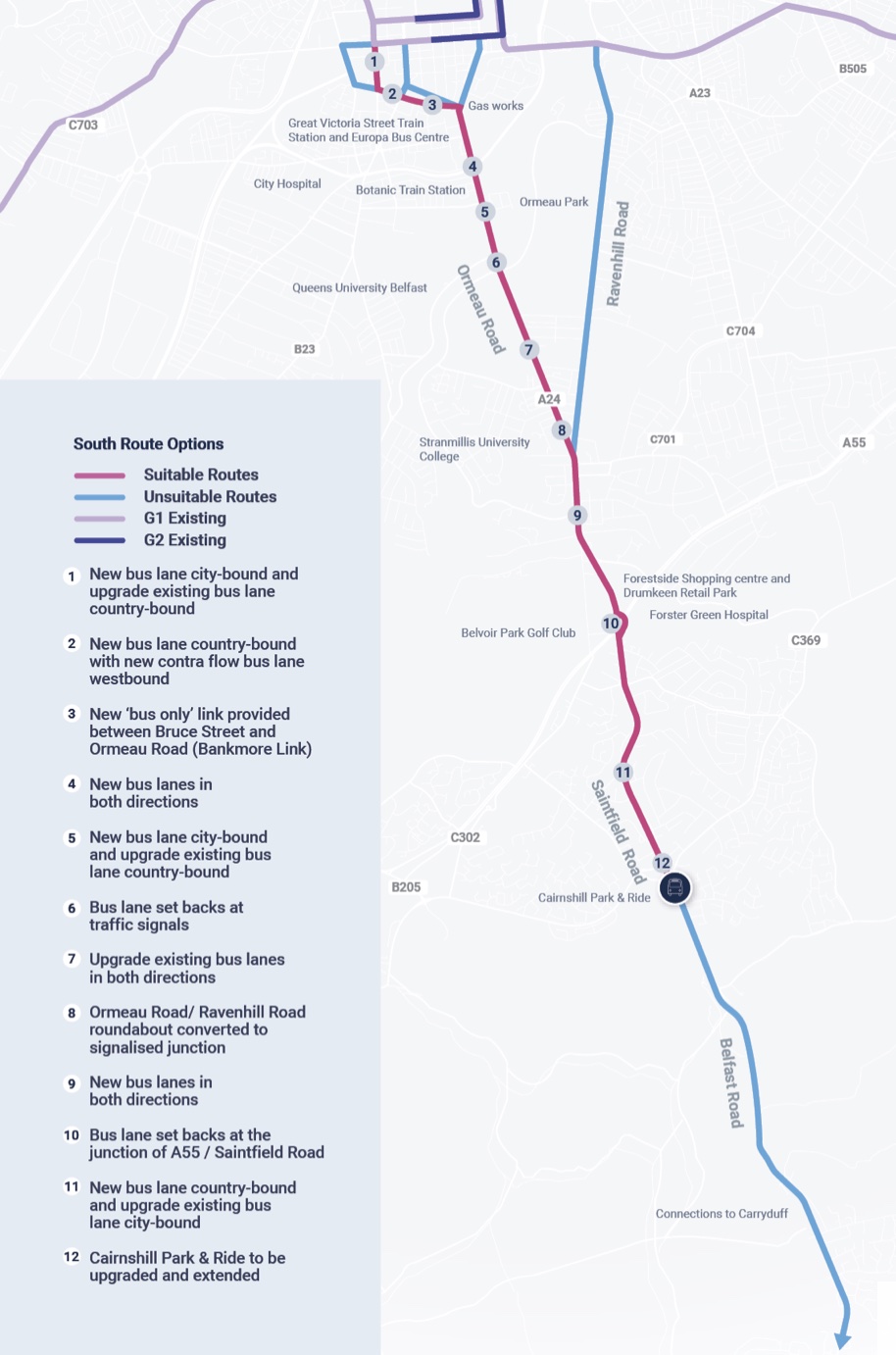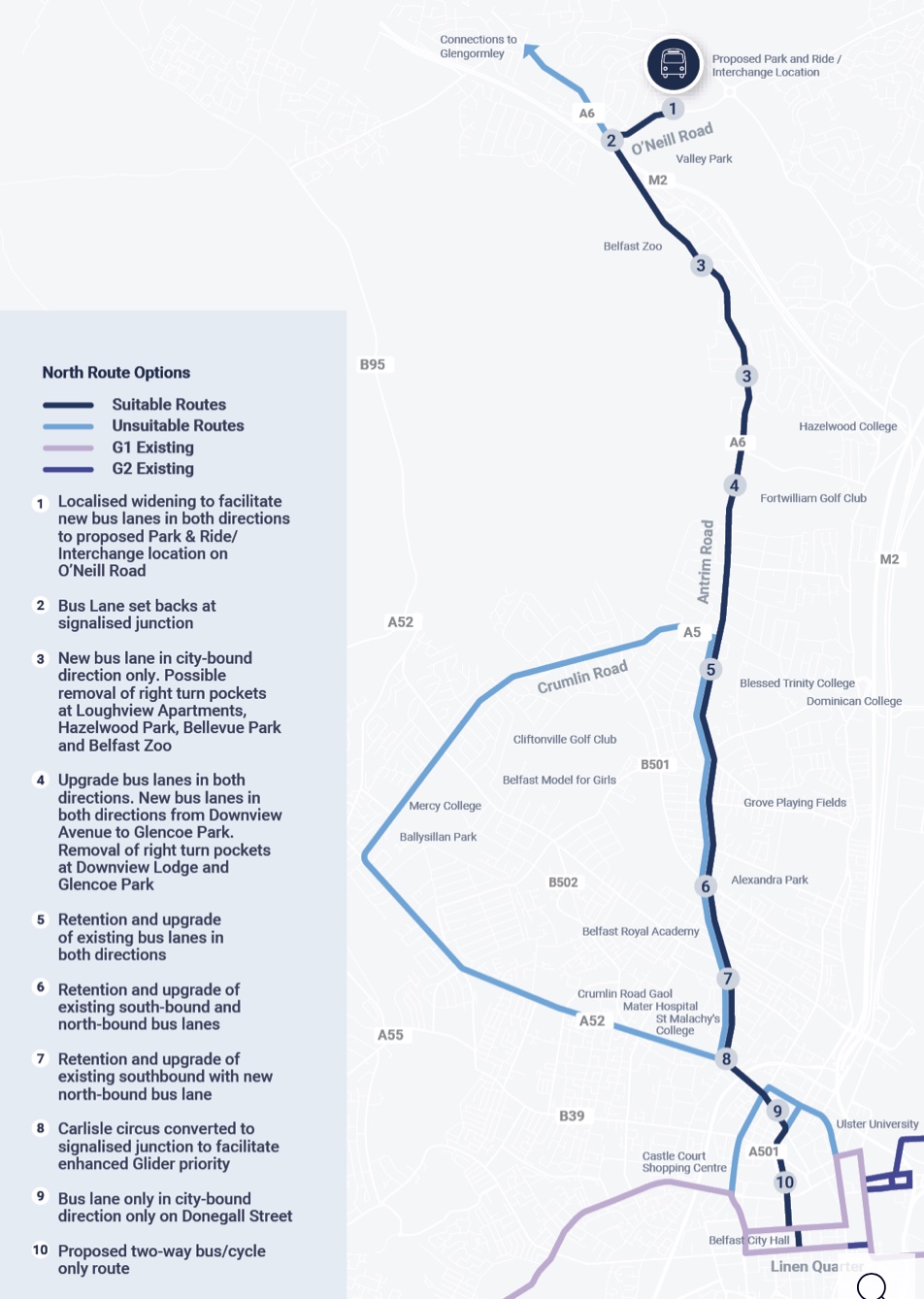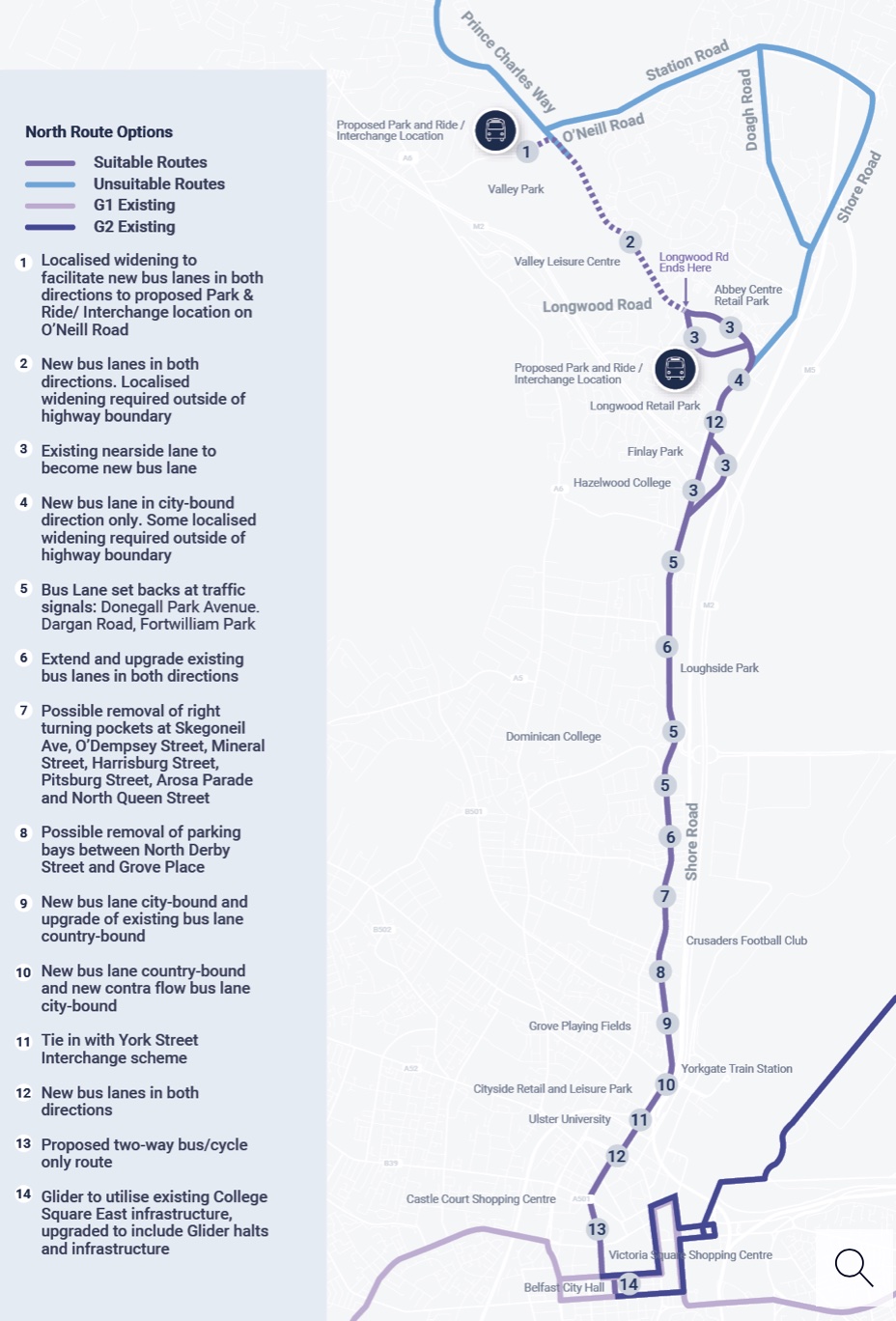|
|
Status
|
Construction
scheme (future) |
|
Where
|
To
expand the Glider rapid transit system
to the north and south of the city, as
well as extending the existing G2
service to include Queen's University
and Belfast City Hospital. |
|
Total
Length
|
3.9 miles (6.3 km)
for Southern Route along Ormeau Road
5.3 miles (8.6 km) for Northern Route
along Antrim Road
1.4 miles (2.2 km) for extension to
Glider G2
|
|
Dates
|
2018 - Phase 1 of BRT
opens (East, West and Titanic Quarter)
2018 - Phase 2 received a funding
commitment in the Belfast Region City
Deal
Jul 2021 - preliminary
route options published for consultation
Late 2025 - Phase 1 (some bus priority
routes + G2 extension) to begin (as of
Feb 2025)
Autumn 2028 – Earliest
date for starting services, as of Aug
2023
(changed from Sep 2027 as of Jul
2021)
|
|
Cost
|
£142-148m (as of
2020) - of which £35m funded
by Belfast Region City Deal and £20m
possibly from the UK government New
Deal.
(changed from £70-80m as of 2018)
|
|
Links
|
|
Click here to jump
straight down to updates for this scheme.
Even before Phase 1
of Glider was launched in September 2018, there
was talk within Translink and DFI of a "phase
2". Phase 1 saw an East-West route connecting
Colin Town Centre in west Belfast, through the
city centre to Dundonald (route G1), along with
a shorter route to Titanic Quarter (G2). Phase 2
will see a similar route (G3) added north-south
and will see G2 extended to Queen's University /
City Hospital. The routes proposed in July 2021
are as follows (click to enlarge; all DFI
images):
Extension of Glider route G2 to serve
Queen's and the City Hospital
 |
Proposed Southern Route towards
Cairnshill
 |
Proposed Northern Route Option 1,
towards Glengormley via Antrim Road
THIS OPTION WAS ADOPTED IN OCT 2022
 |
Proposed Northern Route Option 2,
towards Glengormley via Shore Road
THIS OPTION WAS REJECTED IN OCT 2022
 |
Updates
26 Feb 2025: In the previous
update, almost exactly a year ago, I commented
that the scheme has a total value of
approximately £145m but that only £35m was
actually available and that the scheme may need
to wait until more cash was available. Yesterday
the DFI Minister Liz Kimmins announced
that DFI has managed to find an additional £13m
from its own funds, giving a total of £48m. With
this sum – which is only a third of what is
needed – the Minister has decided to proceed now
with part of the scheme. To be clear, I
get no sense that the rest of the scheme is not
going to happen. Rather, with it being unclear
when the additional c£100m will become
available, she has decided to be pragmatic and
split the scheme into phases and build part of
it now rather than waiting until the full sum is
available before doing anything. So what is
going to go ahead later in 2025 is:
- The construction and opening of the G2
extension to Queens University/City Hospital,
along with purchasing four new Glider vehicles
for the city's fleet to allow this to be
serviced. Note: G2 is currently the route from
Titanic Quarter to the city centre and the
plan is to extend it through the city centre.
- Building some of the
Glider-compatible bus lanes that will be
needed on the G3 route to North Belfast and
South Belfast, though not on the full length
of either route.
- The park-and-ride at O'Neill Road in
Newtownabbey, which will eventually be the
terminus of the G3 North Belfast route. It
will not be serviced with Glider vehicles yet,
but rather with existing Metro buses. Note:
The G3 South Belfast route will terminate at
the existing Cairnshill park-and-ride site.
- Provision of Bankmore Link in the city
centre - though it's not clear in what form,
see the page for that
scheme for more on that.
- Additional bus-priority measures in the city
centre. These aren't spelled out, but it's
probably the route along Donegall Place/Royal
Avenue as well as Great Victoria Street and
Hope Street.
Once this phase of the project is done we will
have the existing G1 service to East and West
Belfast, and an enhanced G2 service which will
serve both Titanic Quarter and Queen's/City
Hospital. We will NOT have any of G3, though
some of the infrastructure will have been built.
The remainder of the scheme will have to wait
for an additional £100m in future years. This
money will be needed to (a) complete the bus
priority measures on both G3 routes (b) build
the Glider halts with ticket machines along the
G3 route and (c) purchase additional Glider
vehicles. But for now we should see work
commence on the ground later this year and I
look forward to seeing more details of the
timetabling.
The only other thing to comment on is that in
2022 Minister O'Dowd decided that BRT3 should be
extended to Glengormley in the north and
Carryduff in the south. Minister Kimmins has now
reversed that decision, saying that the
extension to Glengormley isn't appropriate
pending a public realm scheme in Glengormley
(though it was problematic anyway due to the
lack of space for a dedicated bus lane on the
full length) and that the extension to Carryduff
doesn't make economic sense. This latter point
is probably partly due to the general lack of
caash, but probably also due to the relatively
low expected return it would bring compared to
what it would cost to built. You can see her
full comments here.
21 Feb 2024: The new DFI Minister was
asked about the finance for this scheme in a
Written Question and he answered last week
(question AQW 5670/22-27). He said that the
scheme was estimated to cost around £145m. This
is the same as the 2020 estimate, so I would
suggest it's probably a bit more than that now,
given the rate of construction inflation since
then. He confirmed that £35m has been secured
from the Belfast Region City Deal (which we
knew). He said that the £20m from the UK's New
Deal funding programme has been "paused". This
happened in 2023 by the Secretary of State for
Northern Ireland during the Stormont
interregnum, so may be reinstated in due course.
He noted that he scheme is still £110m short of
cash. DFI engineers don't appear to be too
concerned about this, as the scheme is still in
planning, and most transport schemes don't get
funding at this early stage. However, this money
will eventually need to come from somewhere if
the project is to happen, and with DFI already
low on cash and a lot of attention being focused
on the A5, Rapid Transit 2 may need to wait for
a bit when it gets close to construction.
18 Aug 2023: DFI Roads this week released
a document showing how the current roads
programme will be prioritised in the current
economic and legislative climate, where DFI is
now required to de-carbonise transport. BRT made
the cut, but DFI did say more about the
significant funding shortages the scheme is
facing. It now seems that, in addition to the
£35m from the Belfast Region City Deal, DFI are
also hoping to get £20m from the UK's New Deal
funding programme. This gives total funding of
£55m which is still significantly less than the
£142-148m required. DFI say that this will not
scupper the project, but will rather mean it
will likely be delivered in phases, with phase 1
focusing on reconstructing the roads themselves
to provide the necessary bus priority measures.
The Glider halts and vehicles themselves would
then presumably be funded through future funding
allocations. The scheme is not yet ready to go
out to tender, with the outline business case
still under development and detailed design not
yet started. DFI do, however, indicate that the
scheme "could" be operational five years from
now in autumn 2028. I'd regard this date as a
fairly rough estimate.
27 Oct 2022: Just six days before he was
forced to leave his caretaker role by the
Assembly rules, the DFI Minister published the
"preferred route" for Phase 2 of Glider on 21
October. I am not going to go into lots of
detail here about the lines of reasoning as they
are all set out in the report that is linked
from the press
release. Basically the southern route will
follow Ormeau Road, as expected, as far as
Cairnshill park-and-ride. The northern route,
which was more contentious, will follow Royal
Avenue, North Street and then the Antrim Road to
O'Neill Road at the south side of Glengormley.
The G2 extension to Queen's University and City
Hospital will proceed as planned. From a roads
perspective this will mean both that Carlisle
Circus will cease to be a roundabout and the Bankmore Link
will probably be built, albeit for buses only.
You may notice that the press release states
that the southern route will extend to Carryduff.
However, the document itself explicitly
recommends against this saying that the stretch
from Cairnshill to Carryduff has very few retail
or employment sites and patronage would be
expected to be very low. Similarly, the report
does not recommend an extension of the northern
route through Glengormley town centre as some of
the roads it would need to pass along are only
one lane each way, meaning no bus lanes are
possible without demolishing property, which
would significantly slow down the Glider.
Notably, the Minister has instructed DFI to
explore these options anyway. As he says in the
press release "I have decided that the north
and south routes should extend to Glengormley
and Carryduff, respectively; however, the
feasibility of such will be further assessed
as part of the detailed design".
Proceeding with these extensions against the
recommendations of the report could certainly
happen, but would need to be a political
decision if the business case could not be made.
The most important point that keeps getting
missed in discourse about this project is that
it is estimated to cost £142-148m but only £35m
has been allocated, meaning that unless the
non-existent Executive stumps up an additional
c£110m this scheme will not happen. With no
functioning Executive this is actually the
default eventuality.
10 Aug 2022: DFI recently published
the "first day briefing" that was given to the
DFI Minister John O'Dowd when he entered his
post in May 2022. The information therein notes
that the current estimated cost of BRT Phase 2
is £142-148m (source, 2020 Ourline Business
Case), which is double the estimated cost in
2018). It also repeats what we knew (see
previous update) that the scheme has only been
given £35m of funding in the Belfast City Deal,
which represents 25% of the total cost. That is
plainly a big problem, as proceeding would thus
require the Executive to come up with an
additional c£110m. Given the current economic
climate; the fact that DFI doesn't even have
enough funding for its committed projects, let
alone new ones; and the non-existence of an
Executive this seems unlikely at the present
moment. So my feeling is that while planning for
this scheme will continue, it is unlikely to
move to construction in 2024/25 as previously
hoped.
2 Mar 2022: In my previous update below
I reported that BRT Phase 2 had been granted
funding from the Belfast City Deal, and that
this secured the future of the project. However
it has since emerged that the amount of money
allocated by the City Deal is £35m, which is in
fact less than half the £70-80m estimated cost.
Last week the DFI Minister described
this as a "significant funding shortfall"
and "insufficient to deliver the project".
DFI will now need to talk to the Executive and
the City Deal people to try to secure the
additional £35-45m that will be required to
complete the project. In the current climate of
a partially-collapsed Executive this may not be
easy, so this could be a serious spanner in the
works for BRT. However, there is no reason why
planning can't continue in the interim and that
is what is happening. The Minister has confirmed
that work is progressing on the development of a
Public Consultation Report and Outline Business
Case, which are the next steps to be taken.
16 Jan 2022: The Belfast Region City
Deal was signed
on 17 December 2021. This is the source of
funding for the Phase 2 of BRT, so it makes the
future of the scheme a bit more secure. The
scheme is still in early planning stages, so
it's a moot point in terms of timescale.
Currently the earliest possible completion date
is September 2027.
8 Sep 2021: DFI launched
a public consultation into the route options for
BRT2 on 26 July. You can see details of the
proposals here, and the
public consultation document can be downloaded
(for now) here.
The proposals have already attracted a lot of
attention (not all positive) in the media and on
social media, and I would strongly encourage
anyone with views on BRT2 to respond to the
consultation. You have until 4 October to
respond. I would stress that the purpose of the
consultation is to give the public a chance to
respond to the various route options - the
routes have NOT yet been decided. I have
included maps of the options further up
this page, but the three proposed routes are as
follows.
- To extend the existing G2 service, that
connects the City Centre to Titanic Quarter,
south to the City Hospital and Queen's
University via Shaftesbury Square and then
Lisburn Road, Elmwood Avenue and University
Road. Elmwood Avenue would become one-way
eastbound under these proposals.
- To provide a Glider route south from the
City Centre south along Great Victoria Street,
then east along a new bus-only road from Bruce
Street to Cromac Street, then south along
Ormeau Road and the Saintfield Road, past
Forestside and terminating at the existing Cairnshill
Park-and-Ride.
- To provide a Glider route north from the
City Centre along Donegall Place and Royal
Avenue, and then either along Clifton
Street to Carlisle Circus (which would become
a signalised crossroads) then Antrim Road to
Glengormley, terminating at a new
park-and-ride site located at O'Neill Road
or else along York Street and then the
Shore Road to the Abbeycentre, wjhere there
woudl be a park-and-ride site, then inland
along Longwood Road and Church Road to a a new
park-and-ride site located at O'Neill Road.
The first two are relartively uncontroversial
but - as expected - the North Belfast options
have unfortuinately, but not surprisingly, been
more controversial. The basic reason for this is
that the Antrim road serves a primarily Catholic
area while the Shore Road serves a primarily
Protestant area. This has led politicians to
take different views on the route. From a purely
construction point of view, the Shore Road is
probably easier to construct given that it is
already the equivalent of four lanes in width
along the entire stretch, whereas the Antrim
Road reduces to two lanes around the zoo.
However, the Antrim Road route is 2 km shorter
and has a larger number of sites that could
attract users, including the Mater Hospital,
Belfast Castle, Belfast Zoo and two large
secondary schools (St Malachy's and Blessed
Trinity). The Shore Road would serve Cityside
Retail Park, Hazelwood College, Grove Leisure
Centre, Seaview Stadium and the Abbeycentre.
One possible solution would be to build a
circuit that took in both routes, perhaps with
both clockwise and anti-clockwise services. The
main disadvantage of this would be that it would
double the length of required infrastructure and
significantly raise the costs.
Other than these points, perhaps the most
questioned proposal is to terminate at the city
side of Glengormley, rather than extending the
route through the village towards Sandyknowes. A
park-and-ride at O'Neill Road would not be
attractive to people travelling from further
afield, as it would involve driving through
suburbia. DFI may be taking the view that people
like this would be served by park-and-ride
facilities such as Templepatrick. The
consultation document concludes that a route
along the Antrim Road through Glengormley
village would require highway widening, woudl be
slowed by general traffic and would have a high
impact on local traffic. It also suggests that
it would compromise Sandyknowes' role as a
strategic traffic route. As someone who lived in
Glengormley for several years, I'm not convinced
that the problems are quite that bad, and in
particular I am not sure that it stacks up to
say that it would compromise Sandyknowes'
strategic role, since traffic going into Belfast
from the north is itself strategic, and the fact
that it is changing mode to the Glider does not
make it any less important. However, in fairness
to DFI, they have been trying for some years
without success to acquire a park-and-ride site
near Sandyknowes, so there are other reasons why
it may not be possible.
Finally, it has been noted that BRT2 still does
not attempt to link to the new Belfast Transport
Hub at Grosvenor Road, which is currently under
construction. This still does feel like a
strange decision. One possible option would be
to re-route G1 along Grosvenor Road instead of
Divis Street, though this would involve
decommissioning part of a Glider route that has
only been in operation for three years and would
take services away from sites like Belfast
Metropolitian College. Another option would be
re-route the G2 extension via Grosvenor Road
-> Durham Street -> Bruce Street, so that
it passed closer to the Hub. However, this
option is addressed in the consultation where it
is described as offering "limited carriageway
width and the constrained City Centre nature
[resulting] in lack of ability to provide
high-levels of bus priority". This might
be worth revisiting rather than accepting at
face value, especially since Durham Street is to
be completely rebuilt as part of the Hub works.
In conclusion - read the consultation and, if
possible, respond before 5 October. Construction
is still several years off as a lot more
planning has to be done, and DFI have said that
the earliest operational date for the scheme is
2027, which is still six years away.
10 Apr 2020: The scheme was included in
the Belfast Region City Deal of 2018, and for
this reason DFI are progressing the plans. This
doesn't appear to mean that the scheme will
definitely go ahead. The DFI Minister explained
in February that "...the next stages will
require close working across all departments
and with the other Belfast Region City Deal
partners. The work will include reaching
agreement on funding and on which projects are
most capable of delivering the City Deal
objectives." The first part of the process
is to carry out a feasibility study which will
identify route options. This will also include
cost estimates and cost/benefit analyses and
will help to determine whether the scheme will
be progressed. DFI have said that this
feasibility study is due to be completed before
the end of 2020.
|
|

